This post is a collaborative effort with Ross Katz and our partners at CorrDyn, a data-driven consultancy that helps enable scalable growth. CorrDyn’s data expertise combined with Bluetext’s command of marketing provides an additional opportunity to segment and target in the B2G marketplace.
Where is the next great opportunity for your business? Well, government agencies for one. According to USAspending.gov, approximately five trillion dollars is being allocated to government agencies in Fiscal Year 2021, with over $1 trillion going to Health and Human Services alone. These agencies are growing, and their needs for hardware, software, and services are increasing along with them.
If you are already marketing to “the government,” you understand that winning government contracts is a long sales cycle. The opportunity-to-award process might be 90 days on average, but the lead-up to those 90 days is a critical period where the deal is won or lost. During those 90 days, all data gathering and relationship-building you have done over the previous 2-5 years comes to fruition. So what exactly sets the winning businesses apart? Memorability. Government contracting is a long game, built on endurance. After many years of B2G marketing experience, Bluetext is here to break down what gets your foot in the door and sustains success in business to government marketing.

Division of time between positioning your company for success with government agencies and bidding on specific contract awards.
Winning government contracts is not as simple as pointing your existing sales and marketing engine at a new target. “The government” is not a monolithic entity, and even “the agency” needs to be treated with more nuance: It is composed of dozens of sub-entities that make independent decisions based on independent decision criteria. In enterprise sales, winning over a single decision-maker can often close the deal. In government contracts, groups of stakeholders across the agency influence which business wins the contract, even if a single decision-maker completes the signs off. So instead of persuading a single stakeholder, B2G companies are tasked with winning over multiple groups, at multiple different stages and occasions. Hence, why brand endurance is critical.
Complicating matters further, traditional channels for establishing relationships with government agencies have been disrupted by the pandemic. Most in-person conferences and meetings will not occur this year, and some will remain online for the foreseeable future. Government stakeholders are more geographically distributed and digitally dependent than ever.
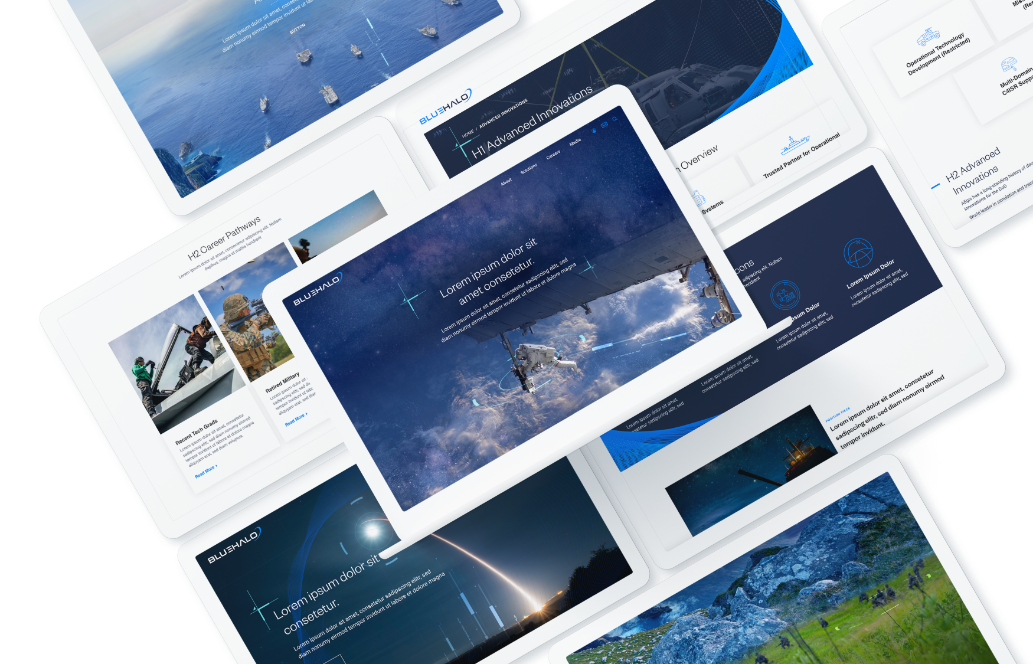
The tides have shifted. Once an industry that operated in an isolated siloe of its own rules, business seeking government contracts must adopt new, digital marketing initiatives to effectively position themselves.B2G companies should leverage the data-driven, digital marketing tools developed for B2C companies to segment and personalize their approach to agency stakeholders. B2G is too broad a term, and even business-to-agency (B2A) abstracts away from the customer understanding your company needs to have to win contracts consistently. A business-to-stakeholder (B2S) marketing approach is what your company needs to win consistently.
To succeed in data-driven B2S marketing, we explore:
- What success looks like in B2S
- The lifecycle of data-driven stakeholder cultivation
- The division of labor between internal departments for successful execution of that lifecycle.
Begin with the End Goal in Mind
Before we determine how to develop our marketing and sales pipeline, we need to define success. Agency leadership and stakeholders can frequently change, at a minimum, with every new government administration.
Therefore, we prioritize targets that will allow your company to evolve as agency priorities and decision-makers change. Your company must first make its impression as a strong, reputable industry player, whilst also remaining top of mind through consistent brand recognition and relevant thought leadership content. These are the characteristics of a successful B2A marketing approach:
- Your company is considered a thought leader in the space where the agency is procuring products and services.
- Government agency stakeholders regularly call your company to ask your opinion on upcoming agency initiatives, product and service specifications, RFPs, and contract awards. Occasionally, you are invited to co-craft the RFP in ways that position your company to win.
- You are aware of the potential for shifting priorities months before those shifts occur.
- Information on the priorities and interests of your agency stakeholders is filtering directly to your sales team, who pass relevant information to content creators, who are crafting bespoke campaigns that reach your contacts as related conversations occur internally at the agencies.
- Business development staff follow up on that content with meaningful conversations with key stakeholders. Those conversations assure your agency contacts that your company is focused on their individual and organizational priorities.
- You have both breadth and depth of relationships at the agency: deep relationships with key stakeholders and associations across the organization. A few people leaving the agency does not impact your company’s ability to retain the status and relationships described above.
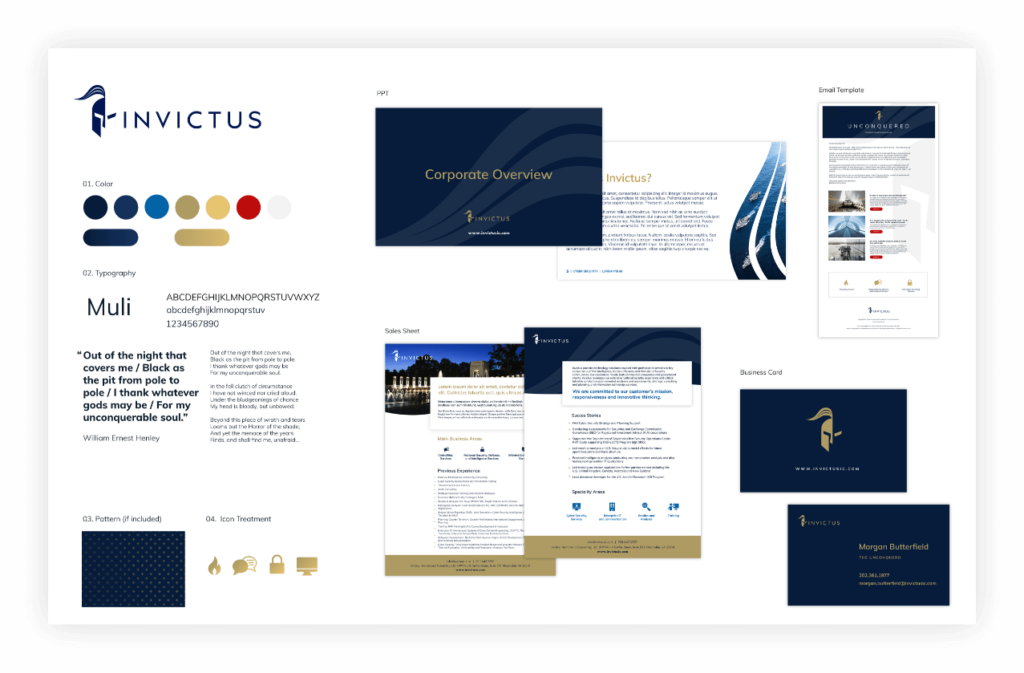
Does your content dress the part? A sure sign of a reputable industry player is professionally branded collateral assets, such as Invictus
The Stakeholder Development Lifecycle
In order to accomplish those goals, start by treating the agency as a combination of individual stakeholders and stakeholder groups. Organize your company’s sales and marketing approach around the Stakeholder Development Lifecycle for B2A marketing, which includes:
- Acquiring Stakeholder Contacts: Start with breadth. In order for your company to establish deep relationships in an agency, you need to acquire as many points of contact as possible. Target ads based on geolocation to get in front of as many relevant stakeholders as possible. Get their title, contact information, and social media presence. Build from there.
- Monitoring Stakeholder Contacts: Capture social media posts, digital content interaction (with a privacy-first approach of course), conference attendance, and internal agency relationship information from contacts over time so that you can understand and target their needs, interests, and priorities.
- Segmenting Stakeholder Contacts: Based on a contact’s position in the organization and their activities and expressed perspectives, segment them into groups that should be targeted and messaged together consistently.
- Nurturing Stakeholder Contacts: Develop marketing, business development, and sales outreach that messages contacts according to their segment and the depth of their relationship with your company. Build a customer journey map that helps you identify what messages move contacts deeper into understanding your company’s value proposition and believing in it.
- Fostering Stakeholder Promoters: Identify your company’s highest value and strongest promoting contacts as the champions your company needs to win individual contract awards. Prioritize according to how naturally the contact aligns with your company’s offerings and how important the contact is to your company’s long-term relationship with the agency.
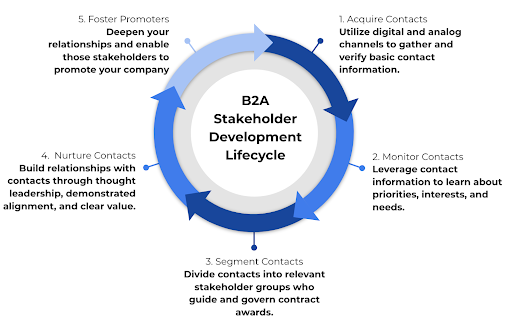
Stakeholder Development Lifecycle for B2A Marketing
Considering Stakeholder Segments
Within each agency, there are groups of stakeholders with priorities that will govern how well your company competes in a given contract award. The priorities of the agency can be efficiently stored within a single person’s head. But understanding the priorities of each stakeholder within each stakeholder group requires a data acquisition and data management approach that efficiently captures, aggregates, and generates insights about how your company is positioned with regard to that stakeholder group and the awards they oversee.
To understand how stakeholder priorities can differ, we use an example company, CyberSample, selling cybersecurity solutions to the Department of Transportation (DoT).
If CyberSample were to interface only with the DoT’s contract oversight and contract administration team, they would get a simplified and sanitized understanding of what governs the contract award. They would miss the critical details and priorities needed to assuage the concerns of each stakeholder group.
If they were to interface only with agency leadership or technology leadership, they would get a sense of broad organizational priorities and gain credibility from being introduced by internal power brokers. However, unless they leverage those introductions to dig deeper into specific needs surrounding an award, CyberSample’s team is unlikely to understand the tactical needs of technology implementers, users, or initiative leaders.
Example stakeholder groups and their corresponding priorities for CyberSample are provided in the figure below.

CyberSample stakeholder segments and their priorities. Segments and priorities should be validated by marketing interactions, public discussions, and business development and sales conversations.
Within each agency and with regard to each industry vertical selling into the agency, there will be a different set of stakeholder groups that influence decision-making. Your first task is to gather the intelligence needed to identify, segment, and target each stakeholder group. Taking a card from the B2C marketing playbook, it’s very similar to traditional customer personas, focus groups, data collection and tracking. Businesses that open their minds to alternative digital marketing and outreach methods are putting themselves miles ahead of the competition. This will allow you to move from a broad B2A approach to a more focused B2S methodology.
Executing on B2S Marketing with a Data-Driven Approach
For the approach described above to be successfully executed, each of your internal departments needs to coordinate. That coordination is built on a shared understanding of the agency landscape. A shared understanding requires a consistent and comprehensive approach to data collection, manipulation, and utilization.
Within the Contact Acquisition phase, your company’s Marketing and Content teams need to develop top-of-the-funnel landing pages, emails, webinars, white papers, and presentations that make agency contacts want to opt-in to a relationship with your company. Your Technology team needs to have the systems in place to capture customer interactions from your web properties and events, as well as to trigger intelligent outreach based on those interactions. Your Data team needs to clean and integrate the information captured from these interactions so that intelligence can filter back to Marketing, Content, Business Development, and Sales.
A summary of your company’s information needs is provided in the table below.
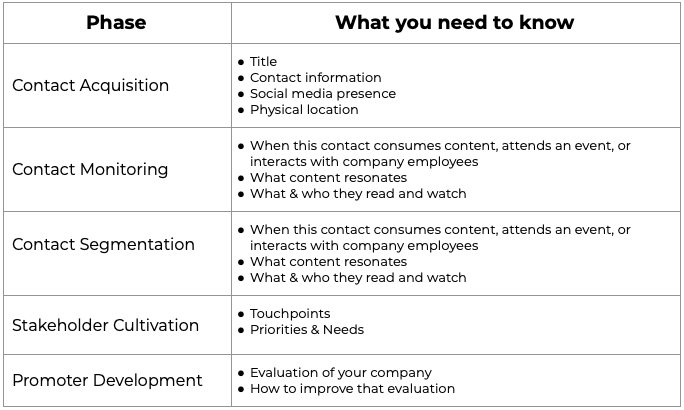
Once your company has acquired contacts and is actively monitoring activity, your Marketing, Content, and Business Development teams need to know what messages are resonating with agency stakeholders, and who are credible thought leaders through which to filter those messages. That provides the platform for new content development and for influencer marketing via the people who already have your stakeholders’ attention.
Those messages also enable the Business Development team to schedule meetings and start having conversations with stakeholders about their individual priorities and the interaction between those priorities and the organization at large. Your company can surface conflicts between agency groups to discover how to navigate potential barriers to contract awards.
Meanwhile, your Marketing team can deepen relationships with agency stakeholders through increasingly targeted messaging that moves those stakeholders closer to being promoters of your business. Your Product & Service team can ensure that your product or service value proposition is aligned with the priorities of each stakeholder group as you enter the RFP process. Your Business Development and Sales teams can focus on the individual needs of key stakeholders and customize your messaging to those stakeholders’ needs.
It is the job of your Data team to ensure that each department has the intelligence they need, when and where they need it, to effectively cultivate those relationships and respond with well-honed sales and marketing messages.
Below, we illustrate the division of labor between different departments throughout the Stakeholder Development Lifecycle.
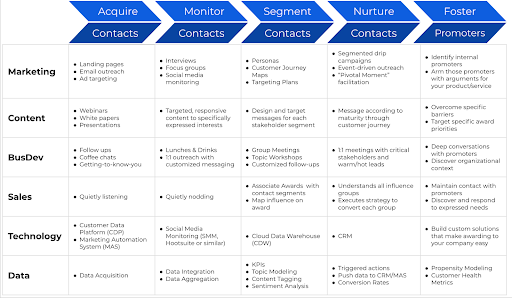
Division of Labor Between Departments for the Stakeholder Development Lifecycle
With an improved strategic approach to B2A marketing, focusing directly on the stakeholders, and a commitment to building the infrastructure and processes to gather and interpret data about them, your company will be better positioned to win government contracts for many years to come. We understand that building the Stakeholder Development Lifecycle from the ground up may be daunting, which is why Bluetext and CorrDyn are partnering to help B2A companies build the systems, processes, and brand assets needed to accelerate your path to agency contract awards.
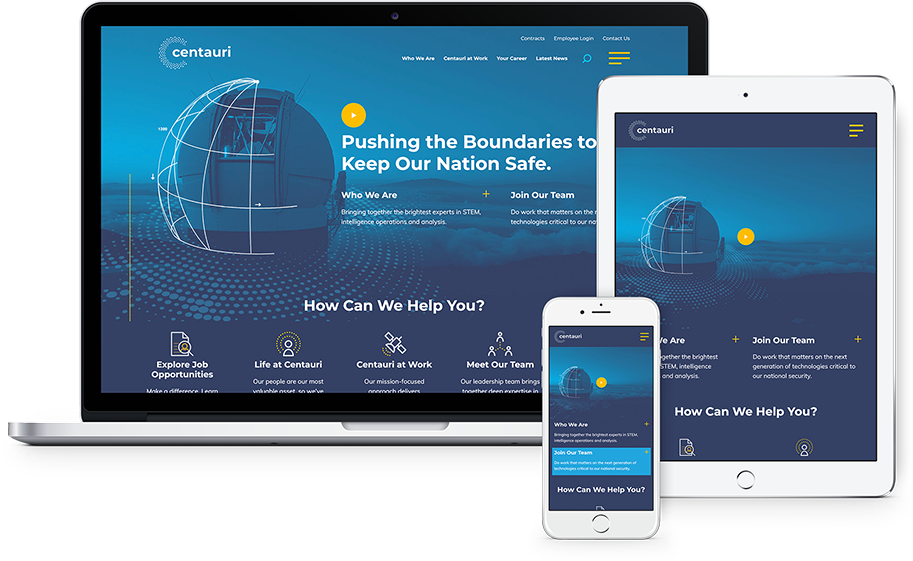
Centauri utilized Bluetext’s services to launch a new name, brand, and website following a merger. Their go-to-market strategy succeeded in winning new awards, company recruits, and even an acquisition from KBR. Check out how Bluetext has set up more brands for M&A success.
How Do I Get Started?
For the approach described above to be successfully executed, each of your internal departments needs to coordinate. That coordination is built on a shared understanding of the landscape within the agency. A shared understanding requires a consistent and comprehensive approach to data collection, manipulation, and utilization.
The starting point depends on the maturity of your company, specifically in the Data and Marketing Teams. For those with fully staffed teams that can execute, you can follow the plan outlined in this post.
The Data Team holds responsibility for timely, reliable access to data to allow the MarCom Team to execute and your other teams to act on the results. If you are still attempting to develop the overall strategy and buy-in from departmental or executive leadership, or if you don’t have the confidence in the systems in place, Bluetext and CorrDyn can help you move forward:
- Data Summit: This workshop is customized to your specific requirements, but is designed to bring together stakeholders from the relevant departments to educate them on the goals of the initiative, gather input from various departments about any concerns or limitations, and move toward a consensus regarding the strategic approach that will improve your targeted marketing efforts.
- Data & Systems Assessment: For those who have made the decision to move forward with improved data-driven marketing, it is critical to have confidence in your data systems (reliability, scalability, and accessibility), data governance (security and policies), and ROI (time to value and budget). Our assessment process addresses all of these aspects and culminates with the development and delivery of a Data Infrastructure and Capabilities Roadmap (DICR). The DICR includes the findings of the assessment, strategic vision, proposed infrastructure solution, and an implementation plan (typically phased).
With the organizational buy-in in place, and you have the data and reliable systems in place, but require assistance in execution in the marketing and content, working with industry-leading partners like Bluetext will allow you to start executing your strategy.
Bluetext brings the marketing and business development expertise needed to elevate your targeting and messaging. CorrDyn brings the data expertise needed to make your web, marketing, sales, and business development data work for you. Reach out to start the conversation about how we can position your company to succeed with government agency marketing and business development.